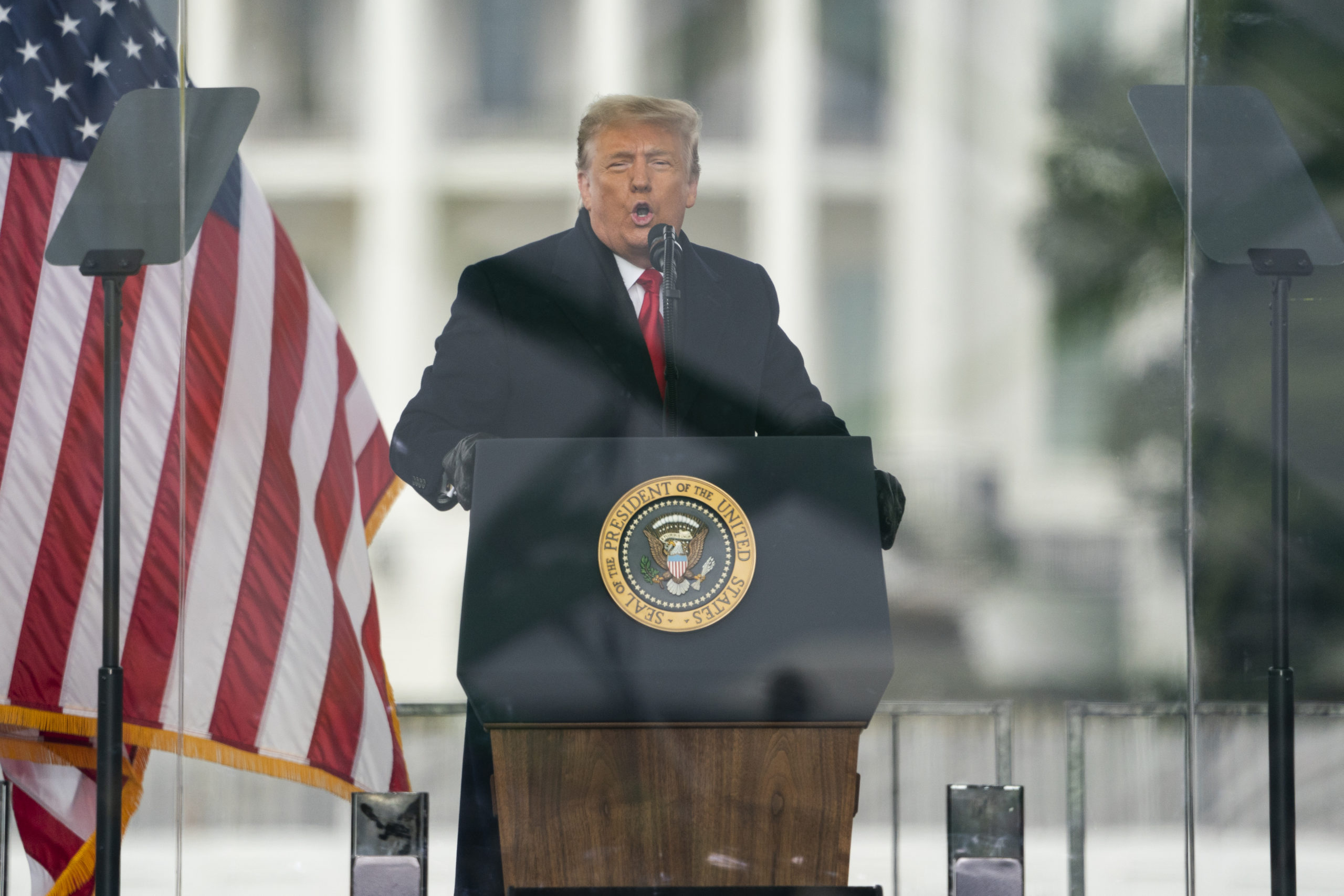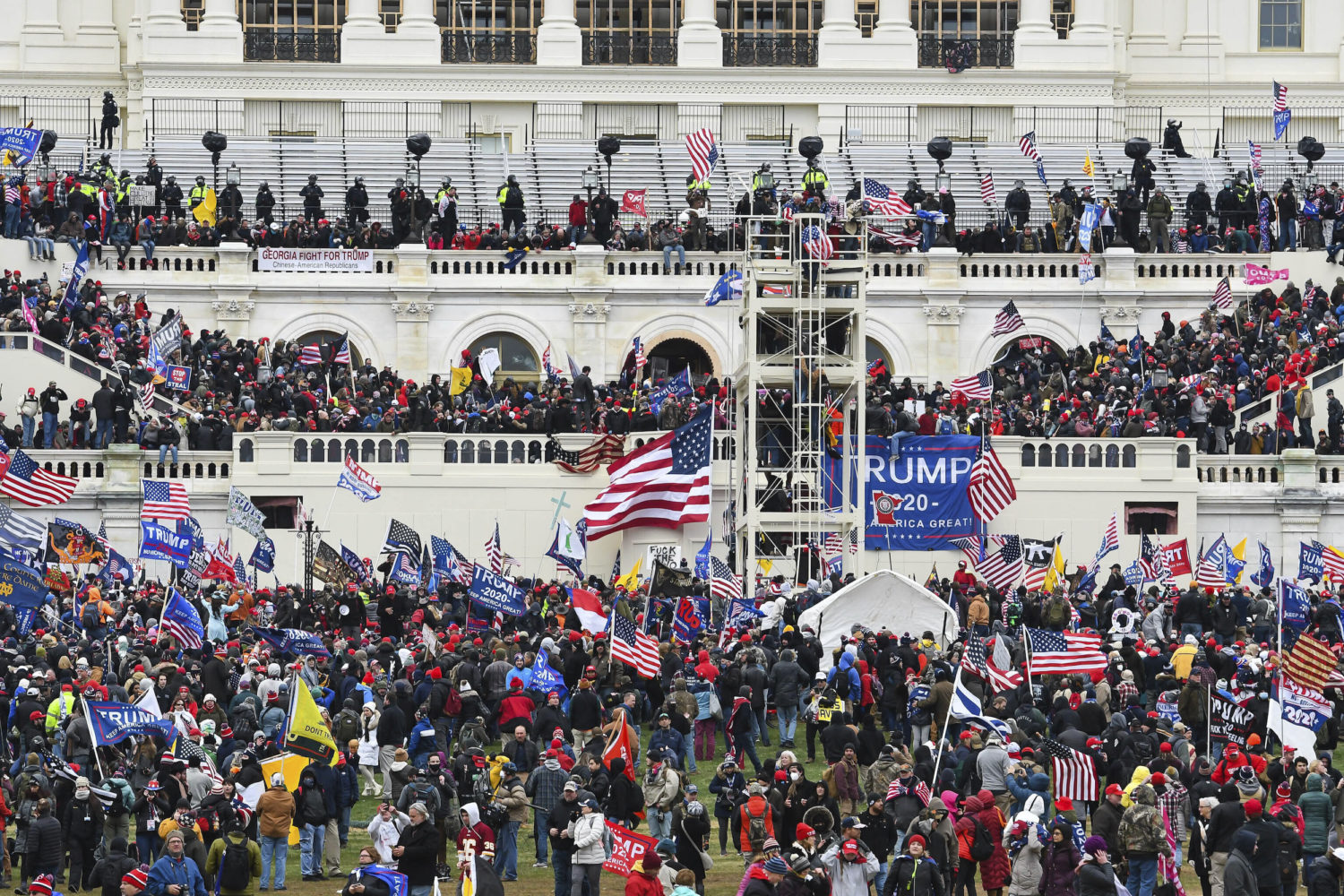Shortly after 2 p.m. on Jan. 6, supporters of President Donald J. Trump breached the U.S. Capitol, turning the seat of American democracy into the scene of an unforgettable crime.
Inside, lawmakers had been preparing to count the Electoral College votes that would bring Trump’s presidency to a close. Outside, the rioters erected a hanging gallows. They waved “Trump 2020,” “Blue Lives Matter” and Confederate flags. Some were armed.
After marching down Pennsylvania Avenue at Trump’s urging, the rioters had overwhelmed police surrounding the Capitol. They pushed past them, stripped them of their weapons, dragged them to the ground, sprayed them with chemical irritants, beat them, bludgeoned them, or tased them.
Through clouds of smoke, they broke down barricades. They scaled the walls. They shattered windows. Congressional staff took cover in offices and closets, piling furniture against doors as the crowd snaked through the building’s historic hallways. The rioters forced their way into House Speaker Nancy Pelosi’s office. They entered the Senate chamber. They reached the dais, where Vice President Mike Pence had sat moments earlier.
Network and cable TV, plus internet sites, broadcast it all live for hours.
Around the nation, people called friends and family as the attack unfolded right before their eyes, expressing a mix of disbelief, horror and fascination:
“Can you believe this?”
Members of Congress, evacuated from their chambers with gas masks in tow, could hardly believe it themselves.
U.S. Rep. Mike Gallagher, R-Wis., called into CNN as the attack was happening. “I have not seen anything like this since I deployed to Iraq in 2007 and 2008,” he said. “I mean, this is America. And this is what’s happening right now. The president needs to call it off. Call it off. It’s over. The election is over.”
On the phone with Fox News that afternoon, House Minority Leader Kevin McCarthy, R-Calif., condemned the attack as “un-American” and “unacceptable.”
“I have been in this Capitol for more than 10 years. I’ve never seen anything like this,” McCarthy said.
As the insurrectionists forced their way into the building, they chanted, “Fight for Trump!” and “Hang Mike Pence!”
Pence, as vice president, had the constitutional responsibility of overseeing the typically quiet certification of state election results by Congress. Although Trump urged Pence to reject results from the battleground states that gave Joe Biden his victory, Pence said he would not intervene, enraging the pro-Trump crowd.
As the chaos unfolded, Trump’s media supporters — who would later downplay and deny what happened in various ways — grew concerned and tried to get messages to the president.
Fox News personalities went through his chief of staff Mark Meadows. ”Mark, the president needs to tell people in the Capitol to go home,” Laura Ingraham of Fox News wrote. “This is hurting all of us. He is destroying his legacy.” Sean Hannity and Brian Kilmeade sent similar messages to Meadows.
McCarthy, the Republican House leader, was able to reach the president directly to ask him to put a stop to what was going on. McCarthy would later evade questions about the call, but other House members said Trump told him, “Well, Kevin, I guess these people are more upset about the election than you are.”
Around 4 p.m., Trump finally asked his supporters to go home. “This was a fraudulent election. But we can’t play into the hands of these people. We have to have peace. So go home, we love you. You’re very special.”
By the night’s end, democracy was still standing. But the manipulation of the narrative was already underway.
In the days that followed, Trump, some of the loudest and most influential members of the Republican Party and vocal partisan media personalities offered a deluge of justifications, excuses and conspiracy theories to reframe the events of Jan. 6 as no big deal.
- They said Jan. 6 was instigated by undercover left-wing activists who were part of antifa. That was proved false.
- They said the rioters hadn’t used force and one Republican congressman likened the events to “a normal tourist visit.” Video proved that wrong.
- They claimed the attack on the Capitol had nothing to do with race, even though white supremacists and far-right militia groups were among the most active participants, and many rioters wore racist t-shirts.
- They suggested the whole affair was staged by the government, a false flag operation. Others suggested it was entirely a peaceful protest. All of that was wrong.
- They said that the rioters were political prisoners and shouldn’t face serious charges. A host of federal judges and courts have held otherwise.
The political shapeshifting was striking. McCarthy at first said that “the president bears responsibility” for the riot. Senate Minority Leader Mitch McConnell called it a “failed insurrection,” said that “the mob was fed lies,” and argued that Trump was “practically and morally responsible for provoking the event of that day.”
But soon they tolerated bizarre claims from lawmakers in their ranks, such as that those arrested for rioting were treated worse than prisoners at Gitmo and that federal agents may have been instigators.
The two Republican leaders disparaged bipartisan efforts to investigate Jan. 6. “There is no new fact about that day that we need the Democrats’ extraneous ‘commission’ to uncover,” McConnell said in a statement.
Even Pence, whose life was in danger, downplayed the unprecedented attack as just “one day in January.”
PolitiFact had many options to choose from for our Lie of the Year: claims that the 2020 election was stolen, claims that the COVID vaccine didn’t work, and this one, lies about the Capitol insurrection.
We picked these lies for two reasons. First, the attack was historically important; a federal judge called it “the most significant assault on the Capitol since the War of 1812.” While some members of Congress lodged protests when the Electoral College count was close, as in 2000, or when individual states had close margins, like Ohio in 2004, never before had Americans overtaken the Capitol to hold up electoral proceedings and threaten lawmakers. In fact, “the peaceful transfer of power” has long been a hallmark phrase in describing, with pride, the American experience.
Second, the events of Jan. 6 were widely broadcast on that day and many days afterward, allowing the public to see for itself exactly what happened. The body of evidence includes direct video documentation and many eyewitness accounts. So efforts to downplay and deny what happened are an attempt to brazenly recast reality itself.
“It’s meant to sow doubt and make us unable to react in the ways we need to react to what is actually a threat to democracy,” said Kate Starbird, an associate professor and expert in misinformation at the University of Washington.
Lies about the Jan. 6 Capitol attack and its significance is the 2021 Lie of the Year.
Change the evidence: Jan. 6 was a peaceful “tourist visit”
Soon after Jan. 6, people trying to dismiss the day’s importance plucked out isolated images to portray the throng as peaceful people simply walking through the Capitol.
Lou Dobbs, a former Fox Business Network host, dismissed the idea that it was a “full-on riot with armed looters going through the building.” Dobbs said on that very day it wasn’t what he saw.
“As I watched, at least, on a number of occasions, looking at the Statuary Hall, the protesters who had invaded the Capitol were walking between the rope lines. It was really a remarkable scene.”
Months later, U.S. Rep. Andrew Clyde, R-Ga., focused on the same images.
“Watching the TV footage of those who entered the Capitol and walked through Statuary Hall, showed people in an orderly fashion staying between the stanchions and ropes taking videos and pictures,” Clyde said during a May committee hearing. “If you didn’t know the TV footage was a video from Jan. 6, you would actually think it was a normal tourist visit.”
Clyde’s words belied his own actions that day. A Roll Call photographer shared an image of Clyde helping barricade the House chamber door as rioters disrupted Congress. PolitiFact rated his statement about a “normal tourist visit” as Pants on Fire.
Trump said the protesters were downright affectionate.
“It was zero threat, right from the start, it was zero threat,” Trump told Ingraham in March. “Look, they went in, they shouldn’t have done it. Some of them went in, and they are hugging and kissing the police and the guards.”
Capitol Police Sgt. Aquilino Gonell didn’t think so. Gonell told Congress he thought he was going to die as he sought to protect the Capitol. Gonell said officers were “punched, kicked, shoved, sprayed with chemical irritants, and even blinded with eye-damaging lasers by a violent mob” and at one point he felt himself losing oxygen as he was crushed by the rioters.
“I’m still recovering from those ‘hugs and kisses’ that day that (Trump) claimed that so many rioters, terrorists, were assaulting us that day,” Gonell said. “If that was hugs and kisses, then we should all go to his house and do the same thing to him. To me, it’s insulting. It’s demoralizing.”
The rioters caused $1.5 million in property damages. They smashed glass windows and door panels, broke furniture, ruined artwork and ripped historic lanterns from the ground. They stole a laptop in House Speaker Nancy Pelosi’s office, documents from the Senate chamber, escape hoods from police officers’ bags and a Capitol Police vest. Some rioters snatched up items from officials’ offices as if they wanted souvenirs — including a bottle of wine and a Fox News football.
A federal judge ridiculed Clyde’s characterization during a defendant’s sentencing hearing in June.
“I’m especially troubled by the accounts of some members of Congress that Jan. 6 was just a day of tourists walking through the Capitol,” said U.S. District Judge Royce Lamberth, a Reagan appointee. “I don’t know what planet these people are on.”
Excuse it: It wasn’t that big a deal

People shelter in the House gallery as protesters try to break into the House Chamber at the U.S. Capitol on Wednesday, Jan. 6, 2021, in Washington. (AP Photo/Andrew Harnik)
Despite evidence showing that dozens of rioters were armed with real and makeshift weapons as they tried to overturn the election, claims that Jan. 6 was “not an insurrection” hardened into a popular talking point.
On her show in February, Ingraham said that the events of Jan. 6 paled in comparison with history’s other insurrections. In June, Fox Business Network host Maria Bartiromo said that calling Jan. 6 an armed insurrection is one of the nation’s “biggest lies.”
Those hosts and others zeroed in on the people who wore costumes into the Capitol.
“Come on, guys. Buffalo head guy was poised to take over the U.S. government?” Ingraham said in July, referring to Jacob Anthony Chansley, the so-called “QAnon Shaman” who wore a horned fur cap. “Are you kidding me?”
Some commentators insisted that because no person has been charged with insurrection, the riot couldn’t be considered one. They objected to fatality counts from the riot, noting that Capitol Police Officer Brian Sicknick’s death the day after fighting with rioters was determined to be from natural causes after suffering two strokes.
Fox News host Tucker Carlson repeatedly denied that Jan. 6 had anything to do with race, falsely claiming that white supremacists bore no responsibility for what happened.
“You know what that was, and you also know what it wasn’t,” Carlson said in January on his Fox News program. “It was not an act of racism. It was not an insurrection.”
Several people with known ties to white supremacist groups were involved, including people now facing conspiracy charges. Symbols of white supremacy and anti-Semitism were prominently on display: a hanging gallows; Confederate flags; racist “Pepe the frog” imagery; a “Camp Auschwitz” T-shirt.
Carlson, Bartiromo and others also described a supposed lack of firearms among the rioters. Radio host Buck Sexton wrote in July that “the most ominous weapon that any of the Jan. 6 organizers seemed to have was QAnon Shaman’s spear, with flag attached.”
Sen. Ron Johnson, R-Wis., minimized the attack by arguing in February that it couldn’t be considered an armed insurrection. We rated that Pants on Fire!
Court documents make clear that many of the people who breached the Capitol that day were armed. As the assault on the Capitol unfolded, Ryan Nichols, a former Marine who carried a crowbar with him, stood on the ledge of a broken Capitol window. “If you have a weapon, you need to get your weapon!” he shouted into a bullhorn.
The rioters brandished bats, crutches, flagpoles, skateboards, hockey sticks, knives, zip ties, chemical sprays, a fire extinguisher and other makeshift weapons, court documents show. They stole and wielded police batons and riot shields. Several had guns on them or stashed nearby.
At least 190 people had been charged with assaulting, resisting or impeding police officers, including over 60 who were charged with using a weapon or causing serious bodily injury to an officer, the Justice Department said in October. More than 65 people have been charged with entering a restricted area with a dangerous or deadly weapon.
The Coup D’etat Project at the University of Illinois’ Cline Center for Advanced Social Research determined shortly after the attack that the storming of the Capitol qualified as an attempted coup.
Several of the weapons charges were filed against members of the Proud Boys, Oath Keepers and other far-right militia groups who wore combat gear and used military-style tactics in the crowd.
Michael Fanone, 40, was one of roughly 140 law enforcement officers injured while defending the Capitol on Jan. 6. Testifying on Capitol Hill in July alongside other officers, he described getting dragged into the crowd, stripped of his badge, beaten, tased and threatened with chants to “kill him with his own gun.” He said he fell unconscious, suffered a heart attack, and was later diagnosed with a concussion, a brain injury and post-traumatic stress disorder.
His testimony did little to chasten the media’s Jan. 6 deniers.
As Fanone spoke, conservative commentator Julie Kelly tweeted that he was a “crisis actor.” Newsmax host Greg Kelly speculated that protesters may have mistaken Fanone as affiliated with antifa, a loosely organized coalition of left-wing anti-fascist activists that has counter-protested and clashed with white supremacists in recent years.
On Fox News, Ingraham mocked Fanone with a sarcastic award for “best performance in an action role.”
Throw everything at the wall: Jan. 6 conspiracy theories

Trump supporters try to break through a police barrier, Wednesday, Jan. 6, 2021, at the Capitol in Washington. (AP Photo/John Minchillo)
Many of the same right-wing voices who went to great lengths to excuse or minimize the attack also teetered between wild conspiracy theories that sought to entirely rewrite what happened.
They suggested that the violence was the work of antifa, a familiar right-wing specter. And when that was proven false, a number of them, led most conspicuously by Carlson, blamed the FBI.
There was no documented trace of antifa at the Capitol, nor was there ever compelling evidence that the FBI or any other government agency instigated the attack. Eleven months later, with more than 700 people facing charges related to the day’s events, there still isn’t.
But talk about antifa and a “false flag” began to take off on anonymous online forums a little after noon EST on Jan. 6, according to PolitiFact’s day-after analysis.
Shortly after the rioters forced their way past Capitol barricades, posts in pro-Trump Facebook groups were already claiming that antifa was behind what was happening. The idea spread on Twitter and Parler, a social media platform popular with conservatives, then to right-wing radio and TV. Several lawmakers endorsed it.
“I believe that this was agitators strategically placed inside of this group — you can call them antifa, you can call them people paid by the Democratic machine — but to make the Trump campaign, the Trump movement, look bad, and to make this look like it was a violent outrage,” said Rep. Madison Cawthorn, R-N.C., as he phoned into Turning Point USA founder Charlie Kirk’s radio show a little after 3 p.m.
“This has all the hallmarks of Antifa provocation,” Rep. Paul Gosar, R-Ariz., tweeted at 5:04 p.m. He had posted a photo of the pro-Trump crowd at the rally hours before.
Between 5 and 6 p.m., antifa was mentioned nearly 156,000 times across social media, broadcast and traditional media, and online outlets, according to an analysis from Zignal Labs Inc., a media intelligence firm.
The rumor was part of multiple reports on Newsmax, local news stations owned by Sinclair Broadcast Group, and websites like the Gateway Pundit. By evening, it was mentioned on the House floor and each of Fox News’ three biggest primetime programs — including the shows hosted by Ingraham and Hannity, both of whom sent texts on Jan. 6 urging Meadows to tell Trump to call off the rioters.
Blaming antifa for domestic unrest is a well-worn talking point, said Starbird, the misinformation expert, so people were “already primed to believe that things are being caused by antifa.”
But the pro-Trump rioters made clear they didn’t want give up the credit. They proudly touted their attack, live-streaming themselves from the Capitol, posing for pictures with statues, interviewing with nearby reporters and boasting about their escapades on social media.
“It was not Antifa at the Capitol,” one rioter tweeted. “It was freedom loving Patriots who were DESPERATE to fight for the final hope of our Republic.”
The evidence didn’t seem to matter. Within months, another conspiracy theory developed, claiming that Jan. 6 was an inside job — a false flag operation orchestrated by the FBI.
This one took off thanks to a little-known, right-leaning website called Revolver News, run by Darren Beattie, a former Trump White House speechwriter who was fired in 2018 after appearing on a panel with a white nationalist.
The website’s unproven theory focused on charging documents and the fact that the FBI had used informants and undercover operatives to foil an extremist plot to kidnap Michigan Gov. Gretchen Whitmer.
A cursory look showed the theory was rife with holes, inaccuracies and circumstantial speculation. PolitiFact rated the claim that federal agents directly incited people as False.
But the next day after the Revolver News article appeared, Carlson told his millions of viewers that “the FBI was organizing the riots of Jan. 6.” Beattie came on as a guest.
InfoWars founder Alex Jones said later that he had provided feedback to Revolver News on the article, and that he had helped get it into Carlson’s hands.
Carlson followed up with op-eds and segments promoting the FBI false flag theory. Daily Wire host Candace Owens tweeted that it was “common sense.” House Reps. Marjorie Taylor Greene, R-Ga., and Matt Gaetz, R-Fla. tweeted out clips of Carlson’s interview with Beattie.
In a House floor speech, Rep. Louie Gohmert, R-Texas, cited the Revolver News article and said he saw Carlson’s segment on it. “This is like Putin kind of activity,” said Gohmert.
Months later, Carlson featured Beattie as a star player in “Patriot Purge,” a three-episode series about Jan. 6 that pushed the FBI and antifa conspiracy theories further.
According to Carlson’s documentary, the FBI had a dystopian end goal. The show warned, falsely, that Jan. 6 was not only a false flag, but a pretext to justify a “purge” of Trump voters — a “new war on terror” that would turn the national security apparatus inward and strip millions of their rights.
The show turned the Jan. 6 perpetrators into victims. They weren’t attacking democracy; they were victims of the deep state. The tactic allowed Trump supporters to “fight the sort of cognitive dissonance of who you think your side is, and what you think you’re about,” Starbird said.
Dismiss it: Further investigation isn’t necessary

FILE – In this Jan. 6, 2021, file photo President Donald Trump speaks during a rally protesting the electoral college certification of Joe Biden as President in Washington. U.S. Capitol Police officers who were attacked and beaten during the Capitol riot filed a lawsuit Thursday, Aug. 26, against former President Donald Trump, his allies and members of far-right extremist groups, accusing them of intentionally sending insurrectionists to disrupt the congressional certification of the election in January. (AP Photo/Evan Vucci, File)
The loudest deniers of what happened on Jan. 6 weren’t shouting into a void. As Carlson and others pushed their false narratives about antifa and the FBI, Republican lawmakers responded to the attack with another form of downplay: silence.
Months after the siege, even those who initially condemned the attack decided that the day was no longer worth talking about. Americans had learned enough about what happened, they said. There would be no need to probe further. Outrage was unnecessary. It was time to move on.
McCarthy and McConnell, both outspoken in the wake of the attack, corralled their members to shoot down a bipartisan bill that would have formed an independent commission in the mold of the body that investigated the terrorist attacks of Sept. 11, 2001.
“I think we have a pretty good idea what happened (on Jan. 6); I was here,” said Sen. John Cornyn, R-Texas, in late May. “And this is unlike the 9/11 Commission in that respect.”
“The Jan. 6 commission would have ultimately been one party investigating the other,” Rep. Michael Burgess, R-Texas, said in June.
The bill was sponsored by Homeland Security Committee Chairman Bennie Thompson, D-Miss., and Ranking Member John Katko, R-N.Y. McConnell said it was slanted because the chair, appointed by the Democrats, would have hired the staff. McCarthy called it “duplicative.”
The bill passed the House in May with support from 35 Republicans, who defied McCarthy’s recommendation to vote against it. The 175 Republicans who opposed the commission included some who had at first spoken out against the rioters, including Gallagher, the Wisconsin representative who told Trump to “call it off” on CNN. About a week later, the Senate’s Republicans killed the bill.
“It isn’t designed to produce a serious inquiry,” Sen. Marco Rubio, R-Fla., tweeted. “It’s designed to be used as (a) partisan political weapon.”
When the House responded with a measure to form its own select committee, all but two Republicans in the House voted against it. Few stood up to defend their vote during a floor debate. More than two dozen skipped the debate entirely, opting instead to spend the day with Trump at the border.
“We need to spend our time finding solutions and helping Americans, not creating partisan commissions to do work that has already been done competently by the U.S. Senate and by law enforcement,” said Rep. Michelle Fischbach, R-Minn., on the House floor.
The committee that ultimately formed includes just two Republicans, both outliers in their own party. McCarthy withdrew all five of his recommendations after Pelosi rejected two of them.
“We will run our own investigation,” McCarthy vowed in July.
But he never did.
“There’s nothing I have that can add to that day,” McCarthy told a local TV station during an interview in September. Pressed about his own phone call with Trump on Jan. 6, he added: “I have nothing to hide, but I have nothing to add.”
It was a stunning about-face for Republicans who have otherwise said they support the police and law-and-order measures.
Despite the claims of partisanship, the goal of the Jan. 6 rioters was to stop a legitimate election process by force, noted Tom Nichols, a former Republican who writes about democracy and politics.
“I have never seen a situation where elected officials’ lives were in danger, and they downplayed what happened,” Nichols said. “Those protesters did not differentiate between Republicans and Democrats — they were going to hang Mike Pence.”
What lies about Jan. 6 tells us about American democracy

Liz Cheney, R-Wyo., on Tuesday, Dec. 14, 2021. (AP Photo/J. Scott Applewhite)
Nearly a year later, there is zero evidence to say that Jan. 6 was an antifa operation, a tourist visit, a false flag, or an uneventful day to forget.
The falsehoods were not without isolated criticism on the right. Fox News correspondent Geraldo Rivera criticized the “outrageous and uncorroborated” claims in Carlson’s documentary series. The two co-founders of The Dispatch, both Fox News contributors for years, resigned in November from the network over the series. Chris Wallace, the network’s premier journalist, recently left the network; NPR reported that Wallace had expressed concerns to network leadership about the Carlson documentary.
Rep. Liz Cheney, R-Wyo., who rejected Trump’s false election fraud claims and voted to impeach him over what happened on Jan. 6, is one of two Republicans to serve on the House select committee, and used her standing to blast the “false flag” conspiracy theory.
“It’s un-American to be spreading those kinds of lies, and they are lies,” Cheney said.
But the repetition of the Jan. 6 falsehoods demonstrates that a political movement can coalesce around obvious lies — and that, despite the facts, it can be difficult to stand against.
“This is our new world — denial of what your eyes are actually seeing,” said Laura Thornton, director and senior fellow at the Alliance for Securing Democracy at the German Marshall Fund of the United States.
“The effort to rewrite history in the service of political power goals is not unheard of in America or anywhere else,” said Theda Skocpol, a Harvard political scientist who has studied the Tea Party and anti-Trump resistance. “What is brazen is the history they want to rewrite includes pictures of what actually happened.”
“Because Jan. 6 was not successful, now they have to rewrite history and in some cases they were doing that in 24 hours, saying you didn’t see what you saw,” added Phillipe Copeland, clinical assistant professor at Boston University School of Social Work.
So far, the consequences for what happened before, during and after Jan. 6 have been limited to rioters like the “QAnon Shaman” who were charged or sentenced for storming the Capitol.
Political leaders and pundits, on the other hand, are going about business as usual. Trump, acquitted in the Senate for a second time, may run again in 2024. McCarthy is angling to take back the speakership. Carlson remains one of the most-watched cable news hosts on TV.
Meanwhile, Cheney was cast out of the mainstream of the Republican Party when the House removed her in May from her leadership position after her impeachment vote. Similar moves against Republicans who criticized Trump have taken place across the country.
It’s a sign that elections could remain a contested space for years to come, as Republican grievances about the outcome of the 2020 election fuel the rewriting of election laws around the country. And it’s a sign that Jan. 6 downplay and denial could be hardening into yet another litmus test for Republicans. Primaries in 2022 are shaping up to be contests where pro-Trump loyalists challenge anyone who dissents.
“We are in an extremely dangerous place,” said Thornton. “An attack on your Capitol where people are threatening to murder the vice president is bad enough, but when you have a political party — one of two in our country — that are downplaying or diverting or misrepresenting, it’s extremely upsetting. I don’t know how we come back from that.”
Researcher Caryn Baird contributed to this article.
This article was originally published by PolitiFact, which is part of the Poynter Institute. It is republished here with permission. See the sources for these fact checks here and more of their fact checks here.









